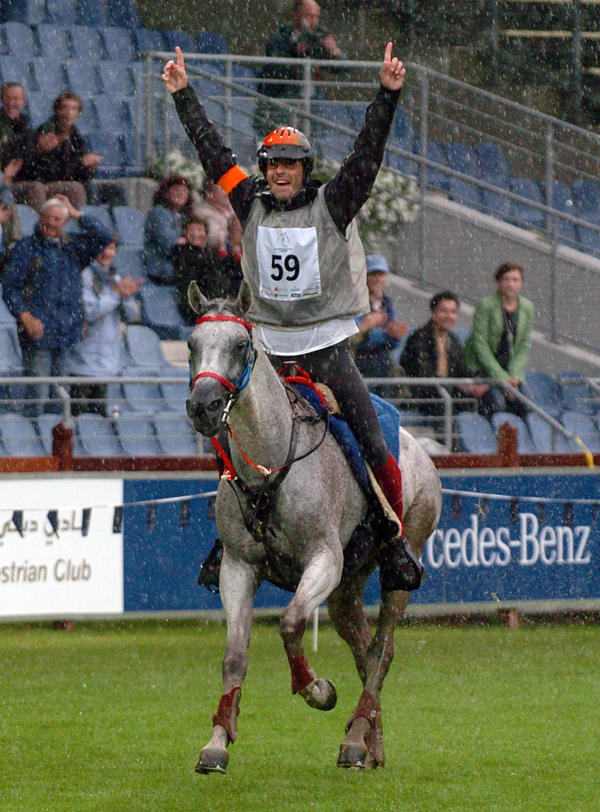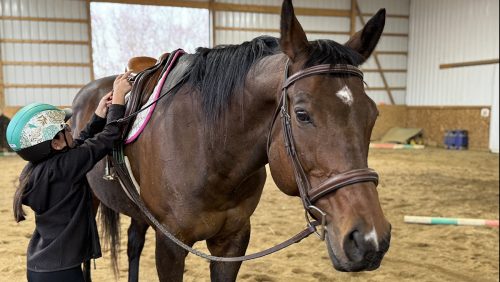When I was at the North American Junior and Young Rider Championships last week, I was driving through downtown Lexington, Ky., and found myself brimming with excitement about the Alltech FEI World Equestrian Games. Not only were there totally beautiful horse statues everywhere, but we drove under a countdown clock to the Games!
There are only 43 days left until the opening ceremonies, so this week I’m exploring another fairly new horse sport: endurance.
Theoretically, endurance riding’s origins are thousands of years old. Since the time when man first tamed horses and trained them for transportation and work, they’ve been the engines behind man’s nomadic ways. However, endurance riding as a modern sport didn’t exist until the early 1900s. Quite a time gap!
Before it became a sport, riding over long distances was simply a means to an end. Organizations like the Pony Express utilized horses to deliver mail and information, just like Genghis Khan created his network of horse stations in the Mongolian steppes in the 13th century. In the mid-1800s, the U.S. Cavalry practiced endurance riding to maintain order in the West.
Endurance as an organized activity was first developed in the United States. Like many of our horse sports, endurance has military roots. It was designed to test the cavalry horses’ ability to carry heavy weight over long distances. The horses were required to carry 300 pounds over 100 miles in one day.
The Morgan Horse Club also had a huge influence on the sport of endurance, as members wanted to create a challenge to prove that Morgans were the best-suited horses for the cavalry. The MHC formed in 1909 at the Vermont State Fair, and shortly thereafter endurance races started. The rides eventually took place all over the country and were extended to 300 miles.
In the 1920s, the U.S. Cavalry created the Mounted Service Cup, which was yet another method of testing cavalry mounts.
Perhaps the most influential moment in endurance’s history came in 1955, when Wendell T. Robie took a bet. He wanted to prove that “modern” horses could cover the Western States Trail, which runs from Lake Tahoe to Auburn, Calif. Robie and a few of his friends completed the first Tevis Cup ride in 1955, and the ride has been contested every year since except for 2008, when wildfires prevented a safe competition. The Haggin Cup, presented to the horse deemed in the best condition, was established in 1964. While many riders strive to win endurance races, the best condition awards are often more valued since they reflect the riders horsemanship as well as their skills in the saddle.
ADVERTISEMENT
The American Endurance Ride Conference was established in 1972 as a governing body for endurance riding in the United States. AERC officials gradually established a firm set of rules to look out for the health and welfare of the horse, while promoting the sport all over the world. In 1982 the Fédération Equestre Internationale recognized endurance as an international sport, and in 1993 endurance became the fifth team discipline under the U.S. Equestrian Team. The first world championships were held in 1986 in Pratoni del Vivaro, Italy.*
Today, the AERC oversees more than 700 rides each year, and they also encourage the use and protection of riding trails, especially historic trails like the Western States Trail. While you couldn’t use them as WEG-qualifiers, there are many multi-day rides that follow routes such as the Pony Express Trail, the Chief Joseph Trail, and the Lewis and Clark Trail. For the ultra-brave, you can even participate in the Mongul Derby, which closely follows Genghis Kahn’s postal system.
Some of you are probably thinking that endurance riding could be considered a glorified trail ride, but let me assure you, after getting lost in the woods trying to find these guys, it’s no walk in the park!
At the endurance ride at the WEG this year, horses and riders will cover 100 miles, and the best combinations will usually complete the ride in 12 hours or less, including five mandatory checkpoints, where horses are thoroughly examined by veterinarians before they head back out on the trail.
In addition to competitive endurance riding, an organization called The Long Riders Guild was created in 1994 to “represent men and women of all nations who have ridden more than 1,000 continuous miles on a single equestrian journey.”
Endurance riding has often been regarded as a true test of horsemanship, and one of the few sports in which any horse-and-rider combination can participate. Whether you choose to go for the Tevis Cup, or simply participate in a 25-mile fun ride, crossing the finish line at the end of the day is always a rewarding experience.
*This information has been corrected. Thanks to The Carrot blog for pointing out the error.
The endurance competition at the Alltech FEI World Equestrian Games begins on Sunday, Sept. 26, with the award for best condition being presented on Monday, Sept. 27.
ADVERTISEMENT
One of web writer Coree Reuter’s favorite parts of working at The Chronicle of the Horse is adventuring up into the attic. While it’s occasionally a journey that requires a head lamp, GPS unit and dust mask, nearly 75 years of the equine industry is documented in the old issues and photographs that live above the offices, and Coree is determined to unearth the great stories of the past. Inspired by the saying: “History was written on the back of a horse,” she hopes to demystify the legends, find new ones and honor the horses who have changed the scope of everyday life with this blog.
Curious about anything in particular? Have a question or an interesting topic? Please e-mail Coree, she’d love to hear from you!














